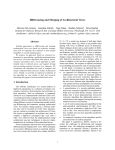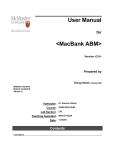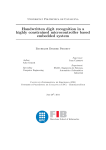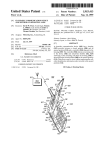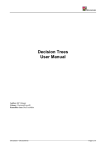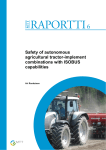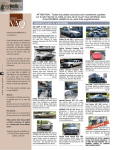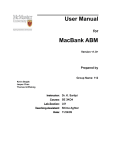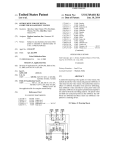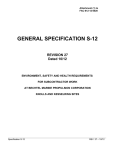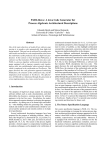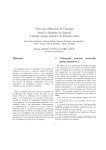Download Differencing and Merging of Architectural Views∗
Transcript
Differencing and Merging of Architectural Views ∗
Marwan Abi-Antoun, Jonathan Aldrich, Nagi Nahas, Bradley
Schmerl and David Garlan
Carnegie Mellon University, Pittsburgh, PA 15213 USA
October 1, 2007
Abstract. Differencing and merging architectural views is an important activity
in software engineering. However, existing approaches are still based on restrictive
assumptions, such as requiring view elements to have unique identifiers or exactly
matching types, which is often not the case in many application domains.
We propose an approach based on structural information. We generalize a published polynomial-time tree-to-tree correction algorithm that detects inserts, renames and deletes, into a novel algorithm that additionally detects restricted moves.
Our algorithm also supports forcing and preventing matches between view elements.
We incorporate the algorithm into tools to compare and merge Component-andConnector (C&C) architectural views. We provide an empirical evaluation of the
algorithm. We illustrate the tools using extended examples, and use them to detect
and reconcile interesting differences between real architectural views.
Keywords: tree-to-tree correction, view synchronization, graph matching
1. Introduction
The software architecture of a system defines its high-level organization
as a collection of runtime components, connectors, their properties and
constraints on their interaction. Such an architecture is commonly referred to as a Component-and-Connector (C&C) view. As architecturebased techniques become more widely adopted, software architects face
the problem of reconciling different versions of architectural models
including differencing and sometimes merging architectural views —
i.e., using the difference information from two versions to produce a
new version that includes changes from both earlier versions.
For instance, during analysis, a software architect may want to
reconcile two C&C views representing two variants in a product line
architecture (Chen et al., 2003). Once the system is implemented, an architect may want to compare a conceptual as-designed C&C view with
an as-built C&C view retrieved from the implementation using various
architectural recovery techniques (Eixelsberger et al., 1998; Murphy
∗
This article is an expanded version of the following paper: Abi-Antoun, M.,
Aldrich, J., Nahas, N., Schmerl, B., and Garlan, D: 2006, ‘Differencing and Merging
of Architectural Views’. In: Proceedings of the 21st IEEE International Conference
on Automated Software Engineering, pp. 47-58.
c 2007 Kluwer Academic Publishers. Printed in the Netherlands.
°
sampkluw.tex; 16/12/2007; 13:23; p.1
2
Differencing and Merging of Architectural Views
et al., 2001; Medvidovic and Jakobac, 2006; Schmerl et al., 2006).
The architect might be interested in implementation-level violations
of the architectural styles or other intent (Abi-Antoun et al., 2005),
or in a change impact analysis (Krikhaar et al., 1999). A runtime
analysis could use the difference information to perform architectural
repair (Dashofy et al., 2002). Finally, during evolution, the difference
information can focus regression testing efforts (Muccini et al., 2005).
Several techniques and tools have been proposed for differencing
and merging architectural or design views. Most techniques do not
detect differences based on structural information. Many assume that
elements have unique identifiers (Alanen and Porres, 2003; Ohst et al.,
2003; Mehra et al., 2005). Others match two elements if both their
labels and their types match (Chen et al., 2003), which is often infeasible when dealing with views at different levels of abstraction. Many
techniques detect only a small number of differences. For instance,
ArchDiff only detects insertions and deletions (van der Westhuizen and
van der Hoek, 2002; Chen et al., 2003), possibly leading to the loss of
information when elements are renamed or moved across the hierarchy.
Tracking changes, using element-level versioning, helps infer high-level
operations, such as merges, splits or clones, in addition to the low-level
operations, such as inserts and deletes (Jimenez, 2005; Roshandel et al.,
2004). But such an approach requires building new tools or changing
existing tools, and cannot handle legacy architectural models.
In this paper, we propose an approach that overcomes some of these
limitations. Our contributions are:
− Differencing and merging architectural views based on structural
information. Tree-to-tree correction algorithms identify matches,
and classify the changes between the two views. Optional type information prevents matches between incompatible view elements,
thus speeding execution and improving match quality;
− A novel polynomial-time tree-to-tree correction algorithm. The
algorithm adapts a recently published optimal tree-to-tree correction algorithm for unordered labeled trees that detects renames,
inserts and deletes (Torsello et al., 2005), and generalizes it to
additionally detect restricted moves. Our algorithm also supports
forcing and preventing matches between elements in the views
under comparison;
− An empirical evaluation of the novel algorithm, and a comparison
with the previously published algorithm;
− A set of tools for the semi-automated synchronization of C&C
views using these algorithms. One tool can synchronize an asdesigned C&C view with an as-built C&C view retrieved from
sampkluw.tex; 16/12/2007; 13:23; p.2
Differencing and Merging of Architectural Views
3
an implementation. Another tool can more generally synchronize
two C&C views, regardless of how they were obtained;
− An evaluation of the tools to find and reconcile interesting differences in real architectural views.
The paper is organized as follows: Section 2 describes the challenges
in differencing and merging architectural views, the underlying assumptions, and the limitations of our approach. Section 3 describes our
novel tree-to-tree correction algorithm. Section 4 presents an empirical evaluation of the algorithm. In Section 5, we use the algorithm to
synchronize architectural C&C views. Section 6 illustrates the approach
using extended examples on real architectural views. Finally, we discuss
related work in Section 7 and conclude.
2. Architectural View Differencing
Software architects rely on multiple architectural views, where a view
represents a set of system elements and the relationships between them.
Views can be of different viewtypes, where each viewtype defines the
element types and the relationship types used to describe a software
system from a particular perspective (Clements et al., 2003). Since a
view is generally described as a graph, view differencing and merging
is a problem in graph matching.
Graph matching measures the similarity between two graphs using the notion of graph edit distance, i.e., it produces a set of edit
operations that model inconsistencies by transforming one graph into
another (Conte et al., 2004). Typical graph edit operations include
the deletion, insertion and substitution of nodes and edges. Each edit
operation is assigned a cost. The costs are application-dependent, and
model the likelihood of the corresponding inconsistencies. Typically,
the more likely a certain inconsistency is, the lower is its cost. Then
the edit distance of two graphs g1 and g2 is found by searching for the
sequence of edit operations with the minimum cost that transform g1
into g2 . A similar problem formulation can be used for trees. However,
tree edit distance differs from graph edit distance, in that operations
are carried out only on nodes and never directly on edges.
Graph matching is NP-complete in the general case (Conte et al.,
2004). Unique node labels enable processing graphs efficiently (Dickinson et al., 2004), which explains why many approaches make this
assumption, e.g., (Alanen and Porres, 2003; Ohst et al., 2003; Mehra
et al., 2005). Optimal graph matching algorithms, i.e., those that can
find a global minimum of the matching cost if it exists, can handle
at most a few dozen nodes (Messmer, 1996; Conte et al., 2004). Non-
sampkluw.tex; 16/12/2007; 13:23; p.3
4
Differencing and Merging of Architectural Views
optimal heuristic-based algorithms are more scalable, but often place
other restrictive assumptions. For instance, the Similarity Flooding
Algorithm (SFA) “works for directed labeled graphs only. It degrades
when labeling is uniform or undirected, or when nodes are less distinguishable. [It] does not perform well [. . . ] on undirected graphs having
no edge labels” (Melnik et al., 2002).
Several efficient algorithms have been proposed for trees, a strict
hierarchical structure, so our approach focuses on hierarchical architectural views. While not all architectural views are hierarchical, many
use hierarchy to attain both high-level understanding and detail. In a
C&C view, the tree-like hierarchy corresponds to the system decomposition, but cross-links between the system elements form a general
graph. Other architectural views, such as module views, have similar
characteristics (Clements et al., 2003). Many approaches are hierarchical (Apiwattanapong et al., 2004; Raghavan et al., 2004; Xing and
Stroulia, 2005). So our choice is hardly new. However, we relax the
constraints of existing approaches as follows:
No Unique Identifiers. For maximum generality, we do not require elements to have unique identifiers, as in other approaches, e.g.,
(Chen et al., 2003; Mehra et al., 2005). As mentioned earlier, this
assumption alone enables the use of exact and scalable algorithms that
can handle thousands of nodes (Dickinson et al., 2004). Unfortunately,
architectural view elements often do not have unique identifiers.
No Ordering. In the general case, an architectural view has no
inherent ordering amongst its elements. This suggests that an unordered tree-to-tree correction algorithm might perform better than one
for ordered trees. Many efficient algorithms are available for ordered
labeled trees, e.g., (Shasha and Zhang, 1997). In comparison, treeto-tree correction for unordered trees is MAX SNP-hard (Zhang and
Jiang, 1994). Some algorithms for unordered trees achieve polynomialtime complexity, either through heuristic methods, e.g., (Chawathe and
Garcia-Molina, 1997; Wang et al., 2003; Raghavan et al., 2004), or
under additional assumptions, e.g., (Torsello et al., 2005).
Renames. A synchronization approach must of course handle elements that are inserted and deleted, as supported by ArchDiff (Chen
et al., 2003). But effective synchronization must also go beyond insertions and deletions, and support renames.
Name differences between two C&C views can arise for a variety of
reasons. For instance, the architect may update a name in one view,
and forget to update another view. Names are often modified during
software development and maintenance. A name may turn out to be
inappropriate or misleading due to either careless initial choice, or name
conflicts from separately developed modules (Ammann and Cameron,
sampkluw.tex; 16/12/2007; 13:23; p.4
Differencing and Merging of Architectural Views
5
1994). Furthermore, developers tend to avoid using names that may be
in use by an implementation framework or library, a minor detail for the
architect. Finally, architectural view elements may not have persistent
names or their names may be generated automatically by tools.
This suggests that an algorithm should be able to match renamed elements. Identifying an element as being deleted and then inserted when,
in fact, it was renamed, would result in losing crucial style and property
information about the element, even if this produces structurally equivalent views. These architectural properties, such as throughput, latency,
etc., are crucial for many architectural analyses, e.g., (Spitznagel and
Garlan, 1998). In the following discussion, a matched node is a node
with either an exactly matching label or a renamed label.
Hierarchical Moves. Architects often use hierarchy to manage
complexity. In general, two architects may differ in their use of hierarchy: a component expressed at the top level in one view could be
nested within another component in some other view. This suggests
that an algorithm should detect sequences of internal node deletions
in the middle of the tree, which result in nodes moving up a number
of levels in the hierarchy. An algorithm should also detect sequences
of internal node insertions in the middle of the tree, which result in
nodes moving down the hierarchy, by becoming children of the inserted
nodes, as shown in Figure 1.
Manual Overrides. Structural similarities may lead a fully automated algorithm to incorrectly match top-level elements between two
trees and produce an unusable output. Because of the dependencies
in the mapping, one cannot easily adjust incorrect matches after the
fact. Instead, we added a feature not typically found in tree-to-tree
correction algorithms. The feature allows the user to force or prevent
matches between selected view elements. The algorithm then takes
these constraints into account to improve the overall match. The user
can specify any set of constraints, as long as they preserve the ancestry
relation between the forcibly matched nodes. In particular, if a is an
ancestor of b, a is forcibly matched to c, and b is forcibly matched to
d, then c must be an ancestor of d.
Optional Type Information. Architectural views may be untyped or have different or incompatible type systems. This is often the
case when comparing views at different levels of abstraction, such as
an as-designed conceptual-level view with an as-built implementationlevel view. Therefore, an algorithm should not rely on matching type
information, and should be able to recover a correct mapping from
structure alone if necessary, or from structure and type information if
type information is available. An algorithm could however take advan-
sampkluw.tex; 16/12/2007; 13:23; p.5
6
Differencing and Merging of Architectural Views
b
T1
T2
r
r
a
a’
c
d
e
b
c
d
e
rename( a --> a’ )
a
c
r
r
s
s
b
e
b
c
d
e
d
delete( a )
b
c
r
r
s
s
d
e
a
e
b
c
d
insert( a )
Figure 1. Tree edit operations.
sampkluw.tex; 16/12/2007; 13:23; p.6
Differencing and Merging of Architectural Views
7
tage of type information, when available, to prune the search space by
not attempting to match elements of incompatible types.
If the view elements are represented as typed nodes, at the very least,
an algorithm should not match nodes of incompatible types, e.g., it
should not match a connector x to a component y. If architectural style
information is available, additional architectural types may be available
and could be used for similar purposes. For instance, an algorithm
can avoid matching a component of type Filter, from a Pipe-andFilter architectural style, to a component of type Repository, from a
Shared-Data architectural style (Shaw and Garlan, 1996).
Disconnected/Stateless Operation. For maximum generality,
we assume a disconnected and stateless operation. A few approaches
require monitoring or recording the structural changes while the user
is modifying a given view (Jimenez, 2005; Roshandel et al., 2004).
Comparable Views. The two views under comparison have to
be somewhat structurally similar. When comparing two completely
different views, an algorithm could trivially delete all elements of one
view, and then insert them in the other view. In addition, the two views
must be of the same viewtype, and must be comparable without any
view transformation. Checking the consistency of different but related
views, such as a UML class diagram and a UML sequence diagram, is
a problem in view integration (Egyed, 2006), and is outside the scope
of this paper.
No Merging/Splitting. Our approach does not currently detect
the merging or splitting of view elements. Merging and splitting are
common practice, but are difficult to formalize, since they affect connections in a context-dependent way (Erdogmus, 1998). We leave merges
and splits to future work.
3. Tree-to-Tree Correction
In this section, we describe a novel algorithm for unordered labeled
trees, MDIR (Moves-Deletes-Inserts-Renames), which generalizes a recent optimal tree-to-tree correction algorithm (Torsello et al., 2005),
which we will refer to as THP. We also implemented THP for experimental comparison with MDIR (Section 4).
3.1. Problem Definition
We first give an unambiguous definition of the problem, adapted from
Sasha and Zhang (Shasha and Zhang, 1997). We denote the ith node
of a labeled tree T in the postorder node ordering of T by T [i]. |T |
sampkluw.tex; 16/12/2007; 13:23; p.7
8
Differencing and Merging of Architectural Views
denotes the number of nodes of T . We define a triple (M, T1 , T2 ) to be
a mapping from T1 to T2 , where M is any set of pairs of integers (i, j)
satisfying the following:
1. 1 <= i <= |T1 |, 1 <= j <= |T2 |;
2. For any pair of (i1 , j1 ) and (i2 , j2 ) in M with:
− i1 = i2 if and only if j1 = j2 (one-to-one)
− T1 [i1 ] is an ancestor of T1 [i2 ] if and only if T2 [j1 ] is an ancestor
of T2 [j2 ] (ancestor order preserved).
We will use M instead of (M, T1 , T2 ) if there is no confusion. To
delete a node N in tree T , we remove node N and make its children
become the children of the parent of N . To insert a node N in tree T as
a child of node M , we make N one of the children of M , and we make
a subset of the children of M become children of N (See Figure 1).
Renaming a node only updates its label and preserves any properties
associated with it. In comparison, THP does not allow any insertions
or deletions in the middle of the tree. It works under the assumption
that if two nodes match, so do their parents, i.e., only subtrees can be
inserted or deleted.
Suppose we obtain a mapping M between trees T1 and T2 . From
this mapping, we can deduce an edit script, i.e., a sequence of edit
operations, to turn T1 into T2 . First, we flag all unmatched nodes in
the first tree as deleted, and all unmatched nodes in the second tree
as inserted. We order the operations so that all deletion operations
precede all insertion operations, delete the nodes in order of decreasing
depth (deepest node first), and insert them in increasing depth order.
To define the cost of an edit script, for each node in the source tree,
we choose a cost of deletion — not necessarily the same for all nodes.
For each node in the destination tree, we choose a cost of insertion —
again, not necessarily the same for all nodes. Finally, for each pair of
nodes (n, m) where n is some node in T1 and m in T2 , we choose a cost
of changing the label of n into the label of m. For example, string-tostring correction changes “banana” into “ananas” with a cost of two
(Wagner and Fischer, 1974). The cost of the edit script is then equal to
the sum of the costs of insertion, deletion, and renaming operations it
contains. Therefore, any given mapping has a unique cost. So, to find
an optimal edit sequence, it is sufficient to find an optimal mapping.
3.2. Explanation of the Algorithm
The algorithm’s pseudo-code is shown in Figures 2 and 3. Let C(i, j)
be the cost of the optimal mapping from the subtree rooted at i to the
subtree rooted at j. A set of nodes S(i) is a successor set of node i if it
is a subset of the set of descendents of i, none of the elements of S(i)
sampkluw.tex; 16/12/2007; 13:23; p.8
Differencing and Merging of Architectural Views
9
is an ancestor of another, and each node of the subtree rooted at i is
either a descendent or an ancestor of an element of S(i).
Given two sets S(i), where i belongs to T1 and S(j) and j belongs
to T2 , it is possible to define the optimal mapping of S(i) to S(j) as
a one to one function from a subset of S(i) into S(j) with least cost.
The cost of mapping element k of S(i) to element l of S(j) is equal to
cost of the optimal mapping of the subtree rooted at k to the subtree
rooted at l. The cost of leaving an element k of S(i) without image
is equal to the cost of deleting the whole subtree rooted at k. The
cost of having an unmatched element l in S(j) is equal to the cost
of inserting the entire subtree rooted at l. This suggests that if we
know all the costs C(d1 , d2 ), where d1 is a descendent of i and d2 is
a descendent of j, it is possible to compute C(i, j) by considering all
possible pairs of sets (S(i), S(j)), and for each such pair, getting the
minimum weight bipartite matching defined by the entries of the cost
matrix C corresponding to the elements of S(i) and S(j).
Finally, let L(i, j) be the cost of changing the label of node i in the
source tree to the label of node j in the destination tree. The minimum
cost obtained added to L(i, j) will be equal to C(i, j). L(i, j) uses
string-to-string correction to evaluate the intrinsic degree of similarity
between the labels of two nodes, using a standard algorithm to find the
longest common subsequence (Wagner and Fischer, 1974).
We choose the best pair (S(i), S(j)) using a branch-and-bound backtracking algorithm. Let DESC(i) denote the set of descendents of i. We
try to choose a subset Q of DESC(i) × DESC(j) with minimal cost.
This is done by trying to add to Q one element of DESC(i)×DESC(j),
such that the new element in Q is consistent with the previous elements,
i.e., no same node can be matched to two different nodes, nor can a
node appear in an element of Q, if either a descendent or an ancestor
already appears in some element of Q. The algorithm backtracks when
it determines that there are no more valid pairs to add, or the cost of the
current branch will be too large to match the best solution discovered
to date. As the problem is NP-complete, the approach outlined above
can quickly become intractable without additional constraints.
We chose to enforce an upper bound B on the sum of distances
between elements of S(i) and the closest child of i (respectively, S(j)
and j), with B typically a small integer. The reasoning behind this
constraint is that nodes are not usually moved too far from their original
positions in a hierarchy. It is also relatively rare for several non-leaf
siblings to be deleted at the same time. The bound B has the additional
benefit that only relatively small neighborhoods of each node have to be
considered for the computation of the optimal cost of a single subtree
pair. This also enables performing many operations efficiently using bit
sampkluw.tex; 16/12/2007; 13:23; p.9
10
Differencing and Merging of Architectural Views
BestSolution: list of node pairs that represents the best
discovered matching between successor sets of two nodes,
where a successor set of node i is denoted by S(i)
CurrentSolution: dynamic list of node pairs that represents
a matching being built between successor sets of two nodes
CostMatrix : CostM atrix[i][j] is the cost of the optimal
mapping from S(i) to S(j)
BestCost: cost of the BestSolution matching
BestGlobalMatch: array of node pairs corresponding to least cost
mapping from T 1 to T 2
BestSuccessor : 2D array of lists of node pairs
(m, n) ∈ BestSuccessor[i][j] means (m, n) is a match between
one element of S(i) and one element of S(j)
in an optimal mapping from S(i) to S(j)
MatchMerit(i , j ): measure of the similarity (i.e., quality of matching, not cost)
between nodes i and j, deduced from CostM atrix[i][j]
as (1 − CostM atrix[i][j]/(sum of subtree weights))
L(i , j ): cost of string-to-string correction to change Label(i) to Label(j)
MDIR(T1 , T2 )
Postorder T1 and T2 nodes
for i ← 1 to T1 .size
do for j ← 1 to T2 .size
do BestSuccessor [i ][j ] = Search(i, j)
CostMatrix [i ][j ] = Cost(BestSuccessor [i ][j ]) + L(i,j)
GetBestMatching(T1 .size, T2 .size)
Search(i, j)
¤ i, j: indices in trees T1 and T2 respectively
Let L be the list of pairs (p, q) where
p is a descendent of i and q is a descendent of j
Sort L according to M atchM erit(p, q)
Set BestSolution = empty list
Set CurrentSolution = empty list
Set BestCost = infinity
Backtrack(0 /* index */, L, 0 /* CurrentCost */)
return BestSolution
Figure 2. Pseudo-code of the algorithm.
sampkluw.tex; 16/12/2007; 13:23; p.10
Differencing and Merging of Architectural Views
11
BackTrack(index, L)
¤ Search for a good mapping between subtrees
¤ index: position reached in list L
¤ L: list of pairs of nodes (m,n) sorted by merit
¤ CurrentCost: sum of the cost of the elements in CurrentSolution
if ( no element of L can be added to CurrentSolution ) ¤ Base case
then if ( CurrentCost + cost of deleted subtrees < BestCost )
then BestSolution = CurrentSolution
BestCost = CurrentCost
return
foreach element l = (m, n) in L starting at index
do
if ( CurrentSolution already contains m, n
or any of their ascendants or descendents )
then continue
if ( adding l to current mapping violates bound B )
then continue
Add cost of match to CurrentCost to obtain NewCost
Get a lower bound E of remaining cost using MatchMerit
if ( E + NewCost >= BestCost )
then continue
Add l to CurrentSolution
BackTrack(index + 1, L, NewCost)
Remove l from CurrentSolution
GetBestMatching(i, j)
¤ Deduce the optimal mapping
¤ i, j: pair of nodes belonging to best possible
¤ mapping between the two trees
foreach element e = (m, n) in BestSuccessor[i][j]
do Add e to BestGlobalMatch
GetBestMatching(m, n)
Figure 3. Pseudo-code of the algorithm (continued).
manipulation. For example, during the backtracking search, checking
whether a node is still available is a single bitwise AND operation,
instead of a loop over an array.
MDIR can be considered a generalization of THP, because THP only
handles the case where B = 0, i.e., only the children of a node can be
sampkluw.tex; 16/12/2007; 13:23; p.11
12
Differencing and Merging of Architectural Views
in a successor set of that node. This produces a fully polynomial time
algorithm that is typically much faster than our generalized algorithm.
Handling non-zero values of B allows MDIR to detect hierarchical
moves. MDIR is guaranteed to find the optimal matching within the
constraints of the bound B, provided it is allowed to run long enough.
In principle, one could use the same implementation for both THP
and MDIR, and adjust MDIR’s parameters to simulate THP, e.g., by
modifying the Search procedure in Figure 2 accordingly. However, we
currently have two separate implementations for MDIR and THP, with
some shared procedures.
It is necessary to limit the running time on trees with more than a
few hundred nodes, and when the average degree of a non-leaf node is
greater than four. We enforce a bound R on the number of recursive
calls of the backtracking search corresponding to a given subtree pair.
Although bound R removes the guarantee of optimality by limiting the
number of recursive calls, MDIR still obtains good results empirically.
Since MDIR uses the branch-and-bound technique, a good match allows
for tight bounds and therefore early cutting of branches. The search terminates normally for matrix entries that correspond to good matches,
and is interrupted only when the match is not good. This allows MDIR
to return an optimal match, even if the backtracking is interrupted
during the computation of cost matrix entries corresponding to matches
that are not part of the optimal solution.
3.3. Illustrative Example
In this section, we illustrate the MDIR algorithm on a small example.
MDIR exhaustively computes from bottom to top the cost of mapping
each node in T1 to every other node in T2 . The computed costs are
stored in a cost matrix. Following the dynamic programming paradigm,
MDIR uses the comparison on the high depth nodes to compare the
low depth nodes. The example also illustrates the usefulness of the
successor set approach, since bipartite matching cannot match subtree
nodes, because of the need to preserve the hierarchical constraints.
MDIR starts by computing the cost of matching D to d (Figure 4).
Similarly, MDIR computes the costs of matching (D, e), (D, f ), (D, g),
. . . , (E, d), (E, e), (E, g). In Figure 5, MDIR computes the cost of
matching B to d. Then, MDIR computes the cost of matching B to b
(Figure 6). This requires knowing the cost of the optimal successor set
mapping for B and b. At this point, MDIR has computed the costs of
matching every descendent of B to any node in the second tree, because
of the post-ordering of the trees.
sampkluw.tex; 16/12/2007; 13:23; p.12
13
Differencing and Merging of Architectural Views
A
T1
a
B
D
C
E
F
T2
b
G
d
e
f
g
(D, d) = 0 (D, e) = 1 (D, f) = 2 (D, g) =3 (D, b) =… (D, a) =…
(E, d) = 1 (E, e) = 0 (E, f) = 1 (E, g) = 2 (E, b) =… (E, a) =…
…
…
…
…
…
…
Figure 4. Cost(D,d) = cost of editing label of D to d, i.e., the measure of similarity
between the labels, in this case 0.
A
T1
a
B
D
C
E
F
T2
b
G
d
e
f
g
(D, d) = 0 (D, e) = 0 (D, f) = 2 (D, g) =3 (D, b) =… (D, a) =…
(E, d) = 1 (E, e) = 0 (E, f) = 1 (E, g) = 2 (E, b) =… (E, a) =…
…
…
…
…
…
…
(B, d) = 12(B, e) = … (B, f) = … (B, g) = … (B, b) =… (B, a) =…
Figure 5. Cost(B,d) = Cost(deleting B’s children) + Cost(editing B’s label).
Assuming the cost of a deletion is 5 times a unit cost, Cost(B, d) = Cost(deleting
D) + Cost(deleting E) + Cost(editing B’s label) = 5 + 5 + 2.
A
T1
a
B
D
C
E
F
T2
b
G
d
e
f
g
(D, d) = 0 (D, e) = 1 (D, f) = 2 (D, g) =3 (D, b) =… (D, a) =…
(E, d) = 1 (E, e) = 0 (E, f) = 1 (E, g) = 2 (E, b) =… (E, a) =…
…
…
…
…
…
…
(B, d) = 12(B, e) = … (B, f) = … (B, g) = …(B, b) = 0 (B, a) =…
Figure 6. Cost(B,b) = Cost(successor set mapping of (B, b)) + Cost(editing the
label of B to b). Cost(D,d) and Cost(E,e) have been previously computed, thus
Cost(B, b) = Cost(D,d) + Cost(E,e) + 0.
sampkluw.tex; 16/12/2007; 13:23; p.13
14
Differencing and Merging of Architectural Views
A
T1
a
B
D
C
E
F
T2
b
G
d
e
f
g
Figure 7. Computing the cost of matching B to b requires the successor set mapping
of the pair (B, b). The successor set mapping of (B, b) is the set {(D, d), (E, e)}.
A
T1
a
B
D
C
E
F
T2
b
G
d
e
f
g
(D, d) = 0 (D, e) = 1 (D, f) = 2 (D, g) =3 (D, b) =… (D, a) =…
(E, d) = 1 (E, e) = 0 (E, f) = 1 (E, g) = 2 (E, b) =… (E, a) =…
…
…
…
…
…
…
(B, d) = 12(B, e) =… (B, f) =… (B, g) =… (B, b) = 0 (B, a) = ?
Figure 8. Cost(B,a) = Cost(successor set mapping of (B, a)) + Cost(editing the
label of B to a) + Cost(deleting b, f and g).
The optimal successor set mapping corresponding to the pair (B, b)
is computed as follows (Figure 7). First, take all the node pairs, where
the first item is a descendent of B, and the second item is a descendent
of b, i.e., the set {(D, d), 4(D, e), (E, d), (E, e)}. The optimal mapping
will clearly be a subset of this set. To obtain that optimal mapping,
we examine all mappings — except the ones that have been pruned
because the bounds on their cost showed they could not be optimal.
The other constraint is: if (x, y) is a pair in a mapping,neither x, nor
y, nor any of their ascendents or descendents, can appear in any other
pair in the same mapping. Thus, the optimal successor set mapping for
(B, b) is {(D, d), (E, e)}. Finally, in Figure 8, MDIR computes the cost
of matching B to a.
At the end of this phase, MDIR has determined the “best” successor set mapping, and stored it for the next phase, when MDIR
will retrieve the best matches. MDIR could avoid keeping the optimal
successor set mapping for each node pair in the first phase, to reduce
the space complexity to O(N 2 ). But it is simpler conceptually to store
this information, and this is how we currently implemented MDIR.
In the second phase, MDIR uses a recursive procedure to compute the match list, i.e., to determine what node corresponds to what
sampkluw.tex; 16/12/2007; 13:23; p.14
15
Differencing and Merging of Architectural Views
A
a
B
D
Step
1
2
3
4
5
C
E
F
b
G
d
Work List
(A,a)
(B,b)(F,f)(G,g)
(F,f)(G,g)(D,d)(E,e)
(G,g)(D,d)(E,e)
(D,d)(E,e)
e
f
g
Match List
(A,a)
(A,a)(B,b)
(A,a)(B,b)(F,f)
(A,a)(B,b)(F,f)(G,g)
Figure 9. Computing the match list.
other node. MDIR uses the following recursive formulation. The list of
matches for subtree pair rooted at (x, y) consists of (x, y), in addition
to the list of matches of each pair in the successor set mapping of (x, y).
In Figure 9, MDIR starts with (A, a). The successor set mapping of
(A, a) is {(B, b), (F, f ), (G, g)}. So, MDIR first adds (A, a) to the match
list, and then adds the pairs (B, b), (F, f ), and (G, g) to the work list.
Then, MDIR pops (B, b) from the work list, adds it to the match list,
and adds to the work list the successor set (B, b), namely, (D, d) and
(E, e). Next, MDIR pops (F, f ) from the work list, adds it to the match
list, and proceeds similarly.
3.4. Forcing and Preventing Matches
Manual overrides are not a standard operation in most tree-to-tree correction algorithms. MDIR has the ability to force and prevent matches
between a node in tree T1 and another node in tree T2 .
Preventing a match between two nodes i and j is easy — just assign
a very large cost to the corresponding entry in the cost matrix C[i][j].
But forcing a match between two nodes is more difficult. At first glance,
it would seem enough to first prevent the match of either of these two
nodes with any node other than the required one, and second, make
the cost of deletion and insertion of these nodes very high. This would
be the case if the algorithm did not have the additional constraint
concerning the distance to the subtree root. Because of this constraint,
it is often necessary to delete entire subtrees at a time, when no match
can be found for any node close enough to the subtree root.
So, we have to avoid deleting one of the nodes involved in the forced
match, during one of those subtree deletions. A possible solution would
sampkluw.tex; 16/12/2007; 13:23; p.15
16
Differencing and Merging of Architectural Views
be to prevent the deletion of all the ancestors of the forcibly matched
node. This is indeed the best solution, if we used THP. But in our
case, this solution could produce a sub-optimal edit script, because it
is possible that a few ancestors were deleted, while the forcibly matched
node was not deleted. This requires distinguishing between individual
delete operations and mass delete operations.
We therefore allow the deletion of ancestors of the forcibly matched
node, on the condition that this deletion operation is not part of a
subtree deletion operation. Whenever an ancestor is deleted, at least
one of its descendents, which is itself an ancestor of the forcibly matched
node, must be part of the successor set. The base case of the recursive
BackTrack procedure enforces this constraint. When computing the
best cost for the (i, j) entry of the cost matrix, if i is an ancestor of a
forcibly matched node, BackTrack does not record in BestSolution
any mapping that deletes the branch leading to the forcibly matched
node. Instead, BackTrack records a mapping that deletes a few intermediate nodes on the path from i to the forcibly matched node. This
feature is not shown in the pseudo-code to keep the latter manageable.
3.5. Runtime and Memory Complexity
An upper bound on the running time of the MDIR algorithm is as
follows: let X be the set of nodes of both trees, x be an element of X,
p be the maximum allowable size of a connected subgraph of the tree
that can be deleted or inserted in the middle of the tree, f (x, p) be
the number of nodes that lie within a distance of (p + 1) from x, and
F (p) = max{f (x, p) : x ∈ X}. Then MDIR’s worst case running time
is O((2 ∗ F (p))!N 2 ).
The average case is considerably faster than the worst case, in our
implementation, due to the following strategies. We prune the search
tree by using both the tree structure and any semantic information,
such as optional type information. We also limit the running time by
returning a possibly suboptimal solution.
In practice, the observed runtime is O(KN 2 ), where K is a large constant. In comparison, THP has a worst case running time of O(d3 N 2 ),
where d is the maximum degree of a tree and d << N (Torsello et al.,
2005). Regarding memory requirements, both THP and MDIR could be
implemented in O(N 2 ) space, at the expense of additional complexity.
Our current THP implementation requires O(dN 2 ), and MDIR requires
O(bN 2 ), where b is a large constant factor.
sampkluw.tex; 16/12/2007; 13:23; p.16
17
Differencing and Merging of Architectural Views
4. Empirical Evaluation
An empirical evaluation of the accuracy of the MDIR algorithm is
necessary because bounds B and R remove the guarantee of optimality.
We generated the test data as follows: 1) generate a random tree with
random labels taken from a pool of 10 possible names, so as they are
non-unique; 2) copy the tree; 3) delete a random number of nodes in
the copy, including both internal and leaf nodes; 4) rename a number of
nodes in the copy; 5) and finally, compare the two trees using THP and
MDIR. The deletion operations in the middle of the tree correspond
to the restricted moves that MDIR detects. We ran MDIR once with
bound R = 100K, and another time with bound R = 5K. We left
bound B unchanged from its default value in all runs.
Table I. Evaluation of MDIR (R = 100K)
Case
#
Nodes
Ideal Ops
Renames
640
1280
640
1280
640
1280
640
1280
569
857
492
1113
441
652
288
576
Deletes
Internal Deletes
Node Degree
THP
Ops Secs
MDIR
Ops Secs
770
1509
701
1397
1076
2407
712
1194
569
963
492
1114
1093
735
288
576
2
7
2
5
3
9
2
10
64
442
50
169
215
471
65
248
The length of an optimal edit script must necessarily be equal to the
sum of the number of deletion and the number of renaming operations.
Table I shows for different tree node sizes, the length of the optimal
edit script, the length of the actual edit script, and the running time
(in seconds), for both THP and MDIR. All numbers were measured on
an Intel Pentium 4 CPU 3GHz with 1.5GB of RAM.
On average, THP produced edit scripts that are sub-optimal by
about 120%, whereas MDIR produced edit scripts that are sub-optimal
by about 7%. In the worst case, THP produced a suboptimal edit script
by about 400%, whereas MDIR’s worst case performance resulted in
an edit script sub-optimal by around 150%. The accuracy deteriorated
significantly for both MDIR and THP, when using nodes of large degree,
or when the trees were very different. MDIR’s worst case was on a
source tree of 640 nodes separated from its target by an optimal edit
script of 440 operations, containing both deletions and renames. In that
sampkluw.tex; 16/12/2007; 13:23; p.17
18
Differencing and Merging of Architectural Views
case, the returned edit script was 2.5 times longer than the optimal
edit script. MDIR produced good results with most trees, even when
the optimal edit script involved 2/3 of the number of nodes. With up
to 85% of the nodes renamed and no deletions, MDIR produced edit
scripts within less than 1% of the optimal script on trees of 640 nodes.
So MDIR can recover the mapping from tree structure alone.
The improved match quality comes at a heavy runtime cost. MDIR
was about 60 times slower than THP on average, with bound R =
100K. As predicted, setting bound R to 5K produced slightly suboptimal edit scripts but noticeably reduced the running time. On a tree
of 1,280 nodes with an optimal edit script of 396 edits, THP produced
an edit script of size 1,775 in 7 seconds. MDIR with R = 100K produced
an edit script of size 459 in 6 minutes, whereas MDIR with R = 5K
produced an edit script of size 479 in 4 minutes. Empirical data with
those two different values of R is shown in Figures 10, 11, 12 and 13.
Varying the bound R did not have much effect on MDIR’s precision.
Note that all the tree pairs used in those figures have internally deleted
nodes, even if this is not the varying parameter.
Figure 10 shows the sub-optimality of the edit script when varying
the percentage of renames, for both THP and MDIR. The worst edit
script for MDIR was suboptimal by around 100%, whereas THP was
off by over 400%. This figure may mislead the reader into thinking
that the accuracy of THP increases with the percentage of renames. Of
course, it does not. THP detects renames but not internal deletes, so
when the percentage of renames in the optimal edit script increases —
compared to the other operations, THP’s precision seems to improve.
Figure 11 shows the sub-optimality of the edit script when varying
the percentage of deletes, for both THP and MDIR. THP generated one
edit script that was suboptimal by over 50%, whereas MDIR generated
fully optimal edit scripts.
Figure 12 shows the sub-optimality of the edit script when varying
the percentage of inserts, for both THP and MDIR. THP generated
edit scripts that were suboptimal by around 110% on average, whereas
MDIR generated edit scripts that were off by 20% on average.
Figure 13 shows the sub-optimality of the edit script when varying the node degree, for both THP and MDIR. THP generated edit
scripts that were suboptimal by over 110% on average, whereas MDIR
generated edit scripts that were off by 16% on average.
The previous data showed mainly the improvement in the precision
of the matching. We also wanted some indication on the algorithm’s
performance and scalability. Ideally, one would generate graphs with
edits that follow the probability distribution of typical graph edits.
Since we did not have such a distribution, we generated random trees
sampkluw.tex; 16/12/2007; 13:23; p.18
19
Differencing and Merging of Architectural Views
% Sub-Optimal Edit Script vs. % Renames
450%
400%
%Sub-Optimal Edit Script
350%
300%
250%
200%
150%
100%
50%
0%
0%
10%
20%
30%
40%
50%
60%
70%
% Renames
THP (N=1280)
THP (N=640)
THP (N=320)
MDIR (N=1280, R=100K)
MDIR (N=640, R=100K)
MDIR (N=320, R=100K)
MDIR (N=1280, R=5K)
MDIR (N=640, R=5K)
MDIR (N=320, R=5K)
Figure 10. A comparison of THP and MDIR (R = 100K, and R = 5K) showing
the sub-optimality of the edit script vs. the percentage of renames.
%Sub-optimal Edit Script vs. %Deletes
60%
%Sub-optimal edit script
50%
40%
30%
20%
10%
0%
0%
10%
THP (N=1280)
THP (N=640)
THP (N=320)
20%
% Deletes
30%
MDIR (N=1280, R=100K)
MDIR (N=640, R=100K)
MDIR (N=320, R=100K)
40%
50%
MDIR (N=1280, R=5K)
MDIR (N=640, R=5K)
MDIR (N=320, R=5K)
Figure 11. A comparison of THP and MDIR (R = 100K, and R = 5K) showing
the sub-optimality of the edit script vs. the percentage of deletes.
sampkluw.tex; 16/12/2007; 13:23; p.19
20
Differencing and Merging of Architectural Views
%Sub-Optimal Edit Script vs. % Internal Deletes
300%
%Sub-Optimal Edit Script
250%
200%
150%
100%
50%
0%
0
5
10
THP (N=1280)
THP (N=640)
THP (N=320)
15
20
% Internal Deletes
MDIR (N=1280, R=100K)
MDIR (N=640, R=100K)
MDIR (N=320, R=100K)
25
30
35
MDIR (N=1280, R=5K)
MDIR (N=640, R=5K)
MDIR (N=320, R=5K)
Figure 12. A comparison of THP and MDIR (R = 100K, and R = 5K) showing
the sub-optimality of the edit script vs. the percentage of internal deletes.
%Sub-Optimal Edit Script vs. Node Degree
350%
%Sub-Optimal Edit Script
300%
250%
200%
150%
100%
50%
0%
0
2
4
THP (N=1280)
THP (N=640)
THP (N=320)
6
8
Node Degree
10
MDIR (N=1280, R=100K)
MDIR (N=640, R=100K)
MDIR (N=320, R=100K)
12
14
16
MDIR (N=1280, R=5K)
MDIR (N=640, R=5K)
MDIR (N=320, R=5K)
Figure 13. A comparison of THP and MDIR (R = 100K, and R = 5K) showing
the sub-optimality of the edit script vs. the node degree.
sampkluw.tex; 16/12/2007; 13:23; p.20
21
Differencing and Merging of Architectural Views
MDIR Performance (R = 5K) vs. Tree Size
1000000
900000
800000
Running Time (ms)
700000
600000
500000
400000
300000
200000
100000
0
0
500
1000
1500
2000
Tree Size (number of nodes)
MDIR_1
MDIR_2
MDIR_3
THP_1
THP_2
THP_3
MDIR_4
THP_4
Figure 14. The performance of MDIR (R = 5K) vs. the tree size.
instead, as before, but with various combinations of deletions, insertions, internal deletes, internal inserts, and renames. Table II lists some
of the different trees we generated.
Although the performance numbers were sensitive to the percentages
of the different kinds of edits, the trends were very similar. Figure 14
shows a plot of the performance of the MDIR algorithm, with R = 5K,
when varying the tree sizes. For comparison, the times for THP are
shown in the corresponding THP series. Our empirical results clearly
confirm our earlier theoretical complexity analysis, i.e., the growth is
quadratic. Although Figure 14 shows that MDIR performs much slower
than THP, it does not give any indication on the accuracy of MDIR
compared to THP, which we previously demonstrated.
We have avoided prematurely optimizing our current implementation to allow for easier debugging, but we think that we can improve
the running time in several ways. Heuristics, such as simulated anTable II. Random trees generated for the performance evaluation of MDIR.
Case
MDIR
MDIR
MDIR
MDIR
1
2
3
4
Deletes
Inserts
Internal Deletes
Internal Inserts
Renames
20%
10%
10%
5%
20%
10%
10%
5%
10%
10%
30%
15 %
10%
10%
30%
5%
40%
60%
20%
15%
sampkluw.tex; 16/12/2007; 13:23; p.21
22
Differencing and Merging of Architectural Views
nealing or genetic algorithms, could significantly improve the Search
procedure by obtaining a better initial solution, and thus a better starting cost. This optimization could yield a significant performance gain,
and allow the implementation to handle larger values of B, as well as
trees of larger degree than is currently possible. Another optimization
would be to reduce the number of nodes in the trees under comparison,
e.g., by adding some nodes as attributes on their parents.
In summary, MDIR has a dramatically improved accuracy over THP
and an acceptable non-interactive performance for many usage scenarios. Unlike exact graph matching algorithms, it can scale to thousands
of nodes and can handle realistic architectural views, as the extended
examples in Section 6 will demonstrate.
5. Architectural View Synchronization
In this section, we use tree-to-tree correction algorithms to synchronize
hierarchical graphs corresponding to C&C views.
5.1. General Approach
We represent the structural information in a C&C view as a crosslinked tree structure that mirrors the hierarchical decomposition of a
system. The tree also includes some redundant information to improve
the accuracy of the structural comparison. For instance, the subtree of
a node corresponding to a port includes additional nodes for all the
port’s involvements, i.e., all the components and their ports reachable
from that port. Each node is decorated with properties, such as type
information. The type information, if provided, populates a matrix
of incompatible nodes that may not be matched. That matrix also
includes optional user-specified constraints to force or prevent matches.
A graph representing a C&C view can generally have cycles in it.
Representing an architectural graph as a tree causes each shared node
in the graph to appear in several subtrees. We consider one of these
nodes the defining occurrence, and add a cross-link from each repeated
node back to its defining occurrence. These redundant nodes, while
they significantly increase the tree sizes, greatly improve the tree-totree correction accuracy. However, they may be inconsistently matched
with respect to their defining occurrences, either in what they refer to,
or in the associated edit operations.
We work around these inconsistent matches using two passes. During the first pass, we synchronize the strictly hierarchical information
corresponding to the system decomposition, i.e., components, ports
sampkluw.tex; 16/12/2007; 13:23; p.22
Differencing and Merging of Architectural Views
23
and representations. During the second pass, we synchronize the edges
in the architectural graph. The post-processing step is simple at that
point, since it has the mapping between the nodes in the two graphs.
Synchronization is a five-step process: 1) setup the synchronization;
2) optionally view and match types; 3) view and match instances; 4)
optionally view and modify the edit script; 5) confirm and optionally
apply the edit script. The final step is optional because the architect
may decline the edit operations for various reasons, or may be interested
only in a change impact analysis (Krikhaar et al., 1999). Because Steps
1 and 5 are straightforward, we will only discuss Steps 2-4.
In Step 2, manually matching the type structures between the two
views produces semantic information that speeds up the comparison.
This optional information can also reduce the amount of data entry for
assigning types to the elements that the edit script will create.
In Step 3, matching instances proceeds as follows: a) build treestructured data from the two C&C views to be compared; b) use treeto-tree correction to identify matches and structural differences; and c)
obtain an edit script to merge the two views.
The tool shows the structural differences by overlaying icons on the
affected elements in each tree (See Figure 15). If an element is renamed,
the tool automatically selects and highlights the matching element in
the other tree. For inserted or deleted elements, the tool automatically
selects the insertion point, by navigating up the tree until it reaches a
matched ancestor. The tool shows in bold a node if it detects differences
in its subtree. The tool shows in italics ports that are inherited from
the component type.
(a)
(b)
(c)
(d)
Figure 15. Figure 15(a) indicates a match; Figure 15(b) indicates a rename; Figure
15(c) indicates an insertion; and Figure 15(d) indicates a deletion.
Various features can restrict the size of the trees and help reduce
the comparison time:
− Start at Component: the user can select any component to be
the tree root, and can reduce the tree sizes by selecting subtrees;
− Restrict Tree Depth: the user can exclude from comparison any
nodes beyond a certain tree depth;
− Elide Elements: the user can exclude selected nodes and their
entire subtrees from comparison. Elision is temporary and does
not generate any edit actions.
The tool gives the user manual control using the following features:
sampkluw.tex; 16/12/2007; 13:23; p.23
24
Differencing and Merging of Architectural Views
− Forced matches: the user can manually force a match between
two elements that may not match structurally;
− Manual overrides: the user can override any edit action suggested by the structural comparison.
Step 4 produces from the edit script a common supertree, that
previews the merged view after the edit actions are applied. In this
step, the user can assign types to elements to be created, change the
types of existing elements, or override types that were automatically
inferred based on the type matching in Step 2. The tool also checks
the edit script for errors, such as illegal element names. The user can
also rename any architectural element that the edit script will create.
Finally, the user can cancel any unwanted edit actions.
5.2. Specialized Tools
This approach supports building architectural view differencing and
merging tools for a wide range of Architecture Description Languages
(ADLs). To evaluate our approach, we represented the C&C views in
the Acme general purpose ADL (Garlan et al., 2000).
We also developed a tool to extract as-built C&C views from ArchJava (Aldrich et al., 2002). Similar tools can extract as-built views from
other an implementation-constraining ADL with code generation capabilities, or an implementation-independent ADL with an implementation framework, such as C2 (Medvidovic and Taylor, 2000).
We intended our synchronization tools to be lightweight enough that
they can fit into a single dialog in an integrated development environment, such as Eclipse (Object Technology International, Inc., 2003),
and not require a specialized environment for architectural recovery
(Telea et al., 2002). Both AcmeStudio, a domain-neutral architecture
modeling environment for Acme (Schmerl and Garlan, 2004), and ArchJava’s development environment, are Eclipse plugins, which reduced
the tool integration effort.
One synchronization tool can make an as-designed architectural
view, expressed in Acme, incrementally consistent with an as-built
architectural view, extracted from an ArchJava implementation. We
still need to change the ArchJava infrastructure to support making
incremental changes to an existing ArchJava implementation based on
changes to the as-designed view.
Another synchronization tool, based on the same approach, more
generally takes any two C&C views represented in Acme. One view
could correspond to a documented architecture. The second view could
correspond to a C&C view recovered using any architectural recovery
technique, e.g., (Schmerl et al., 2006). The second view could also be
sampkluw.tex; 16/12/2007; 13:23; p.24
Differencing and Merging of Architectural Views
25
another C&C view, either retrieved from a configuration management
system, or corresponding to a variant in a product line.
Synchronizing an as-designed C&C view with an as-built C&C view
must often address expressiveness gaps between architectural information at different levels of abstraction. Although we use Acme and
ArchJava to illustrate some of these differences that must be bridged,
synchronizing any pair of as-designed and as-built C&C views may
encounter similar challenges.
Structural Differences. There will always be name differences of
the same structural information between Acme and ArchJava. For instance, an ArchJava port can be named in, a reserved keyword in Acme.
Even if code generation automatically produces a skeleton implementation from the architectural model, connector names and role names
are lost, since ArchJava does not even name those elements. Finally, in
Acme, port names are critical for typechecking. But in ArchJava, port
names are unimportant and obey the standard programming language
notions of binding and scope.
Hierarchy. Acme treats hierarchy as design-time composition, where
a component at one level in the hierarchy is just a transparent view of
a more detailed decomposition specified by the representation of that
component. Multiple representations for a given component or connector could correspond to alternative ways of decomposing an element.
On the other hand, ArchJava views hierarchy in terms of integration of
existing components, along with glue code, into a higher level component. Due to the glue, a higher-level component is semantically more
than the sum of its parts. These differing views of hierarchy create
additional challenges for architectural synchronization. For example, if
multiple representations are present at the design level, there must be a
way to specify which of these representations was actually implemented.
Matching Instances. Obtaining the tree-structured data from Acme
simply converts the Acme architectural graph into the cross-linked tree
structure discussed earlier. Acme does not have first-class constructs
for required and provided methods. In keeping with Acme’s model for
extensible properties, the tool adds properties on a port to represent
its provided and required methods, as well as other salient properties,
e.g., the port’s visibility.
To obtain the tree-structured data from an ArchJava implementation, the tool traverses the compilation units, ignores classes that are
not component types, and fields that are not of component type. Different modeling choices are possible in this case. First, ArchJava does not
name connectors or connector roles. The tool generates synthetic names
from the components and ports that a connector connects to. Second,
the ArchJava top-level component can have ports, whereas the top-level
sampkluw.tex; 16/12/2007; 13:23; p.25
26
Differencing and Merging of Architectural Views
component in Acme, i.e., the Acme system, cannot. One option is to
create a top-level component in Acme to correspond to ArchJava’s toplevel component. Another is to create a synthetic component to hold
these ports. Third, ArchJava ports can be private, whereas all Acme
ports are public. One option is to represent ArchJava private ports as
Acme ports on an internal component instance; another is to simply
ignore private ports.
Matching Types. Assigning architectural styles and types to an
Acme view enforces the architectural intent using constraints (Monroe,
2001). For instance, a constraint on a component type may specify
that all instances of that type must have exactly two ports. Similarly,
setting architectural styles on the overall system — and on each subsystem representation if applicable, enforces any constraints associated
with the style. In Acme, the Pipe-and-Filter style prohibits cycles, a
constraint that a general purpose implementation language, such as
ArchJava, does not directly enforce.
In many design languages, types are arbitrary logical predicates.
An element is an instance of any type whose properties and rules it
satisfies. And one type is a subtype of another, if the predicate of
the first type implies the predicate of the second type. Such a type
system is highly desirable at design time, because it allows designers
to combine type specifications in flexible ways. Acme embodies this
approach, but is hardly unique; for instance, PVS (Rushby et al., 1998)
takes a similar approach. As an example of using a predicate-based
type system, consider an architecture that is a hybrid of the Pipe-andFilter and Shared-Data architectural styles. In this example, a Filter
component type has at least one input and one output port, while
a Client component in the Shared-Data style has at least one port
to communicate with the repository. A component in this architecture
might inherit both the Filter and the Client specifications, yielding
a component that has at least three ports — two for communicating
with other filters and one for communicating with the Repository.
However, implementation-level type systems, such as the ones provided by C2SADL (Medvidovic et al., 1996) or ArchJava, cannot express the example above. A specification that a component has a port
implies a requirement that the environment will match that port up
with some other component. Therefore, conventional type systems require a component type to list all of the ports it might possibly have
— or at least all those ports that are expected to be connected at
runtime. There is no way to express that a Filter component has “at
least two ports” — instead, one must say that the Filter has “at most”
or “exactly” two ports. Therefore, in the implementation, one cannot
sampkluw.tex; 16/12/2007; 13:23; p.26
Differencing and Merging of Architectural Views
27
Figure 16. Matching types between the as-designed Acme model of a simple system
following the Pipe-and-Filter style with its as-built ArchJava implementation.
combine the Filter type with a Repository component type — which
defines a third port that is prohibited by the filter specification.
So a design-level predicate-based type system is fundamentally incompatible with a type system for a programming language. As a result,
the matching algorithm may not rely on exactly matching typing information as in UMLDiff (Xing and Stroulia, 2005). In our approach,
the user specifies arbitrary matches between the type hierarchies from
Acme and ArchJava, flattened and shown side-by-side.
Consider synchronizing the Acme model of a simple system following the Pipe-and-Filter style with its ArchJava implementation. In
Figure 16, the user matches the types as follows. The user selects
the Capitalize, CharBuffer, Lower, Merge, Split, Upper component types in ArchJava and matches them with Filter Acme type.
All the component instances of these ArchJava types will be assigned
the Filter Acme type during synchronization. Using a limited form
of wildcards, the user assigns the Acme type Pipe to the ArchJava
connector type ANY. So any Acme connector created for an implicit
ArchJava connector instance will have that type.
Since ArchJava ports are not typed, the user can individually assign
to an ArchJava port a set of Acme port types. To reduce the manual
sampkluw.tex; 16/12/2007; 13:23; p.27
28
Differencing and Merging of Architectural Views
Figure 17. Validating the edit script can involve renaming some ports to match the
names declared in the Acme type.
work, the user use another form of wildcards. He can assign an Acme
type, e.g., outputT, to any ArchJava port that only provides methods.
Similarly, he can assign the inputT Acme type to any ArchJava port
that only requires methods. In addition, AcmeStudio defines connection patterns for most architectural styles. Based on these patterns,
the tool can infer the Acme role types, once the user assigns types to
components, ports and connectors. For instance, the tool infers the role
type sourceT, based on the source component type Filter, source port
type inputT, and connector type Pipe.
In this case, the synchronization produces the edit script in Figure
17. Since the user mapped the types, the edit script elements already
have types. Each view element that already has a type is displayed using
the same type- and style- dependent visualization that it would have in
AcmeStudio. If the user does not specify architectural types and styles,
the elements that the edit script will create will be untyped. Of course,
the user can set the types on the newly inserted view elements at a later
point in AcmeStudio. Although assigning types during synchronization
seems to duplicate functionality, it may affect the edit script and the
view merging as explained below.
sampkluw.tex; 16/12/2007; 13:23; p.28
Differencing and Merging of Architectural Views
29
For instance, when a component instance is assigned the Filter
component type, it inherits any ports declared on that type, e.g., ports
input and output, of types inputT and outputT. So the tool need
not create additional ports of these types on the component instance.
Based on the user’s selection in Figure 16, the tool matches the ArchJava port portOut — since it only provides methods, with the Acme
type outputT. The tool suggests renaming the port portOut of type
outputT, to match the output port on the Filter type.
The user can accept the corrective actions suggested by the tool
using the Auto-Correct button in Figure 17. In that case, the tool
automatically renames portOut port to output, and updates all the
cross-references in the edit script. The user can also change the assigned
or inferred types before pushing the changes to the Acme model.
6. Extended Examples
In this section, we evaluate the tools for C&C view synchronization in
several extended examples on real architectural views.
6.1. Extended Example: Aphyds
In this example, we synchronize an as-designed C&C view with an
as-built C&C view retrieved from an implementation. This example
mainly highlights the ability of the underlying MDIR algorithm to
detect inserts, deletes and renames.
The subject system is Aphyds, a pedagogical circuit layout application. To evaluate ArchJava’s expressiveness to specify the architecture
in code, Aphyds was re-engineered into an ArchJava implementation
starting with 8,000 source lines of Java code — not counting the libraries used (Aldrich et al., 2002). We chose Aphyds since it had a documented as-designed architecture, and the ArchJava implementation
enables extracting the as-built C&C view using a tool.
The developer of the original Java program informally drew the asdesigned Aphyds architecture in Figure 18. In the following discussion,
the architect performing the synchronization is a third party, with no
prior experience with the original Java program, or with re-engineering
the Java program into the ArchJava implementation.
As-Designed Architecture. The architect created an Acme model
based on the informal architecture in Figure 19(a). He represented the
circuitModel as a single component, and added all the computational
components to a representation of circuitModel in Figure 19(b). In
the original diagram (Figure 18), the thin arrows represent control flow,
sampkluw.tex; 16/12/2007; 13:23; p.29
30
Differencing and Merging of Architectural Views
Figure 18. Informal as-designed Aphyds architecture as drawn by the original
developer.
and the thick arrows represent data flow, but the architect did not make
that distinction and showed all communication as Acme connectors.
Matching Types. The architect chose an Acme Model-View-Controller
style, MVCFam. Since the architect was interested in the control flow,
he assigned the provideT Acme port type defined in MVCFam to any
ArchJava port that only provides methods. Similarly, he assigned the
useT Acme port type to any ArchJava port that only requires methods,
and the provreqT Acme port type to any ArchJava port that both
provides and requires methods. He also assigned the generic TierNodeT
Acme type to all components and the CallReturnT Acme type to all
the implicit ArchJava connectors (See Figure 20).
Matching Instances. The architect used the synchronization tool
to compare the two views. As he was the least sure about how he
represented the circuitModel component in Acme, he decided to focus
on that component first.
sampkluw.tex; 16/12/2007; 13:23; p.30
Differencing and Merging of Architectural Views
31
(a) Top-level Acme model.
(b) Acme representation of the circuitModel component.
Figure 19. As-designed Aphyds architecture represented in Acme.
The tool detected a few renames, e.g., ArchJava uses model instead of circuitModel, and inside that representation, ArchJava uses
globalRouter instead of route (See Figure 21). The architect was
particularly intrigued that the Acme representation for circuitModel
had more connectors than the ArchJava implementation. In Figure 21,
the tool only matched the starConnector which connects components
circuit, partitioner, floorPlanner, place, route and channel in
Figure 19. The architect investigated this further and confirmed that
the Acme connectors corresponding to the thick data flow arrows in
the informal diagram in Figure 18 are not in the implementation.
Since Aphyds was written for academic study and not for industrial
application, it is missing some of the data flows that would be present
in a real application, i.e., the data flow is simulated rather than real. So
the architect accepted the edit actions to delete these extra connectors
from the Acme model.
sampkluw.tex; 16/12/2007; 13:23; p.31
32
Differencing and Merging of Architectural Views
Figure 20. Matching types between Acme (left) and ArchJava (right).
Merging Instances. The architect next turned his attention to the
additional top level component, shown as privateAphyds in Figure
21. Based on the synchronization options he selected, he determined
that the tool created privateAphyds to represent a private window
port in ArchJava and the corresponding glue. After looking at the control flow, the architect assigned that subsystem the Publish-Subscribe
Acme style. He also renamed component privateAphyds to window,
renamed the added connector to windowBus, and assigned windowBus
the EventBusT connector type from the style. The architect also decided
sampkluw.tex; 16/12/2007; 13:23; p.32
Differencing and Merging of Architectural Views
33
Figure 21. Comparison of Acme C&C view (left) and ArchJava C&C view (right):
starConnector matches a connector in ArchJava with an automatically generated
name (highlighted nodes); privateAphyds exists in ArchJava but not in Acme.
to use the same component names as the ArchJava implementation to
avoid future confusion, so he accepted the renames in the edit script.
Discussion. Figure 22 shows the resulting C&C view after it has
been manually laid out in AcmeStudio. Unlike the original architect’s
view, Figure 22 shows bi-directional communication taking place between components placeRouteViewer and model. The architect investigated that unexpected communication, and traced it to a callback.
Aphyds is a multi-threaded application with long running operations
moved onto worker threads. So the architect made note of the fact that
developers should not carelessly add callbacks from a worker thread
onto the user interface thread. Finally, the architect decided to use the
up-to-date C&C view with types and styles for evolving the system.
Performance Evaluation. On an Intel Pentium 4 CPU 3GHz
with 1.5GB of RAM, comparing an Acme tree of around 650 nodes
with an ArchJava tree of around 1,150 nodes (Figure 21) with MDIR
took under 2 minutes. In comparison, THP took around 30 seconds,
but produced less accurate results. In particular, THP did not treat
component privateAphyds as an insertion, and mismatched all the
sampkluw.tex; 16/12/2007; 13:23; p.33
34
Differencing and Merging of Architectural Views
Figure 22. As-built Aphyds architecture with Acme styles and types.
top-level components. For Aphyds, the edit script consisted of over 300
renames, over 600 inserts and over 100 deletes.
6.2. Extended Example: Duke’s Bank
In this example, we synchronize two C&C views, where one the as-built
view is recovered by instrumenting the running system. This example
mainly highlights the ability of the underlying MDIR algorithm to
detect moves in addition to renames.
The subject system is Duke’s Bank, a simple Enterprise JavaBeans
(EJB) banking application. The architect wanted to compare the documented architecture with the as-built architecture, recovered using
an architectural recovery technique other than ArchJava. Duke’s Bank
is also representative of industrial code that uses middleware, and
furthermore, has a documented as-designed architecture.
As-Designed Architecture. The architect converted an informal
diagram (See Figure 23) into an Acme model (See Figure 24).
As-Built Architecture. The as-built architecture was recovered
by a dynamic architecture extraction tool, DiscoTect (Schmerl et al.,
2006). DiscoTect currently generates one component instance for
each session and entity bean instance created at runtime. So the architect post-processed it, and unified such multiple instances into one
sampkluw.tex; 16/12/2007; 13:23; p.34
Differencing and Merging of Architectural Views
35
Figure 23. Informal as-designed architecture for the Duke’s Bank application (Sun
Microsystems, 2006).
Figure 24. Duke’s Bank documented architecture in Acme; the components were
added inside the Acme representation of an EJB container (shown as a thick border).
Session and Entity Beans are grouped.
sampkluw.tex; 16/12/2007; 13:23; p.35
36
Differencing and Merging of Architectural Views
Figure 25. Duke’s Bank recovered architecture in Acme.
instance. The goal was to make the recovered C&C view in Figure 25
comparable to a typical C&C view, where each component instance
represents any number of runtime components.
Matching Types. In this case, the as-built view and the as-designed
view use the same architectural style and types, so the architect skipped
the optional step of matching types.
Matching Instances. The differencing tool correctly detected the
moves corresponding to replacing the container component in one
view with its representation in the other view (See Figure 26). Because a
tool generated the names in the recovered view, e.g., AccountBean e55d75,
there was a large number of renames in this case. The synchronization
tool matched all the elements between the two views, despite the large
number of renames.
Discussion. The tool also identified on Account Controller Bean
a port that was attached to a DbWriter connector. Figure 24 does
not show a connection between the Account Controller Bean and the
DB components. In fact, the EJB specification recommends that all
database access goes through entity beans. In this case, the tool found
an architectural violation in Sun’s own example!
Performance Evaluation. On an Intel Pentium 4 CPU 3GHz with
1.5GB of RAM, MDIR took around 30 seconds to compare the two
Acme trees, one with around 330 nodes, and one with around 390
nodes. In this case, the edit script consisted of over 250 renames and
over 50 inserts. As expected in this case, THP did not correctly identify
the moved view elements.
6.3. Extended Example: HillClimber
In this example, we evaluate the tool to synchronize two C&C views
again, but this time, we allow the user to force matches. All the examples actually use the feature to prevent matches, to avoid matching
elements of incompatible types.
sampkluw.tex; 16/12/2007; 13:23; p.36
Differencing and Merging of Architectural Views
37
Figure 26. Comparison of the Duke’s Bank documented and recovered architectures.
The subject system, HillClimber, is part of a collection of Java applications to graphically demonstrate artificial intelligence algorithms,
built on the CIspace framework. In particular, HillClimber, demonstrates stochastic local search algorithms for constraint satisfaction
problems. HillClimber was re-engineered from about 15,000 lines of
Java (Abi-Antoun et al., 2007). We chose HillClimber because it uses
a framework. A product line architecture often uses a framework as its
platform, and one often needs to compare variants in a product line
(Chen et al., 2003). The implementation technology, ArchJava, also
made it easy to extract the as-built C&C view.
As-Designed Architecture. The applications that use the CIspace
framework follow a simple high-level design. An application window uses
a canvas to display nodes and edges (not shown) of a graph in order
to demonstrate the algorithms provided by the engine (See Figure 27).
As-Built Architecture. We first ran the tool to synchronize the
as-designed C&C view in Figure 27 with a C&C view retrieved from the
HillClimber implementation. In this case, the top-level structure of the
as-designed view was not sufficiently detailed, i.e., the various nodes
have roughly the same number of ports. In such cases, structural com-
sampkluw.tex; 16/12/2007; 13:23; p.37
38
Differencing and Merging of Architectural Views
Figure 27. Base design for a CIspace framework application.
parison alone can produce inaccurate results. In this case, the MDIR
algorithm incorrectly matched the top-level element graph in one view
to window in the other view.
So the user manually forced the matches between the top-level nodes
in the two views, and re-ran the comparison. This time, the MDIR
algorithm took into account these manual overrides when matching
the instances. Having correctly matched the top-level elements, the
comparison highlighted additional differences between the two views.
For instance, Figure 28 shows several missing sub-architectures. But
the user decided to merge only the changes for the top-level elements
and obtained the as-built architecture in Figure 29.
Discussion. In a product line architecture, each instantiation of a
framework often introduces additional runtime dependencies. Indeed,
HillClimber added several connections to the documented architecture, and these connections seem mostly justified. For instance, the
connection between engine and canvas is needed since one of the
sub-components of engine required access to functionality from the
canvas.
7. Related Work
Landmark-based Algorithms. We group several algorithms that
have been proposed for differencing hierarchical information under the
category of “landmark-based algorithms”: they have been proposed
in the context of program differencing, e.g., JDiff (Apiwattanapong
et al., 2004), Dex (Raghavan et al., 2004), and design differencing, e.g.,
UMLDiff (Xing and Stroulia, 2005). These algorithms are based on
the assumption that the entities they are trying to match are uniquely
sampkluw.tex; 16/12/2007; 13:23; p.38
Differencing and Merging of Architectural Views
39
Figure 28. Manual overrides improve matching the instances. The user forced a
match between the engine nodes in the two trees by selecting them both and clicking
on the ‘Match’ button before running the differencing algorithm.
Figure 29. The as-built HillClimber architecture.
sampkluw.tex; 16/12/2007; 13:23; p.39
40
Differencing and Merging of Architectural Views
named and many nodes match exactly. This enables them to recognize
the unchanged nodes first and use them as “landmarks” to efficiently
identify the other changes. However, these algorithms are unable to
match nodes based on structure alone or based on structure and highly
non-unique semantic information, such as entity types. For instance, a
heuristic solution with a worst-case O(N 3 ) supporting arbitrary move,
copy and glue operations was tested on instances where more than 80%
of the nodes matched exactly (Chawathe and Garcia-Molina, 1997). As
a result, these algorithms are less suitable for comparing architectural
views, as they will perform poorly when all the nodes are renamed, or
when most of the renamed nodes are concentrated in one area of the
tree such as when entire subtrees are renamed. This may be atypical
when comparing two versions of a given program or a design model at
a given level of abstraction. In our architectural views, most names are
transient or automatically generated. Both THP and MDIR would still
work even in the total absence of semantic information, i.e., using tree
structure only. For instance, in the Aphyds and Duke’s Bank examples,
our inputs had more than half of their nodes renamed. Finally, none of
these algorithms offer the ability to manually force or prevent matches.
It may be possible to easily add the ability to prevent matches to some
of them (e.g., JDiff), but adding the ability to force matches could be
substantially more complicated.
Tree Alignment vs. Tree Edit. Tree differences can be represented using tree alignment instead of tree edit distance. Each alignment of trees actually corresponds to a restricted tree edit in which all
the insertions precede all the deletions. Algorithms based on tree alignment can detect unbounded deletes and can generalize to more than
two trees, something not easily done with tree edit distance algorithms
(Jiang et al., 1994). But the memory requirements of tree alignment
algorithms, for the tree sizes and branching factors that are typical of
our inputs, would be several orders of magnitude higher than those of
MDIR — O(22d N 2 ), where d is the maximum degree of the tree.
Graph Matching Approaches. Exhaustive graph matching algorithms, based on variants of the A* algorithm (Messmer, 1996), do not
scale beyond a few dozen nodes (Hlaoui and Wang, 2002). In the context
of architectural views, Sartipi proposed an approach for architectural
recovery using a variant of the A* graph matching algorithm, but with
an optimization that may cause it to miss the optimal solution in some
cases (Sartipi and Kontogiannis, 2003).
More scalable, heuristic-based approaches, such as spectral methods,
perform poorly when the graphs are not nearly isomorphic. Furthermore, these algorithms occasionally miss the optimal solution (Conte
et al., 2004). Others, such as the Similarity Flooding Algorithm (SFA),
sampkluw.tex; 16/12/2007; 13:23; p.40
Differencing and Merging of Architectural Views
41
have an accuracy of around 50% (Melnik et al., 2002). The accuracy
of MDIR is above 90% on a roughly similar range of graph sizes.
Furthermore, SFA relies heavily on labels, which are different when
the graphs originate from different domains, even if they express the
same relationships: “while matching of an XML schema against another
XML schema delivers usable results, matching of a relational schema
against an XML schema fails” (Melnik et al., 2002).
Mandelin et al. proposed probabilistic matching based on label,
region, type or position information (Mandelin et al., 2006), but the
approach requires training the evidencers. Mandelin et al. also mention
that a simple greedy search algorithm does not work in many cases.
Model Transformation. Graph transformation approaches, surveyed by Mens and van Gorp (Mens and Van Gorp, 2005), tackle
the same problem, but use a different set of assumptions. First, in
many graph grammars, productions do not delete vertices and edges,
which effectively prohibits insertions and deletions, one of our requirements. Second, graph transformation approaches do not attempt to
find the optimal transformation that would preserve properties of view
elements. Finally, these approaches do not yet offer easy to use tools
such as the ones illustrated in Section 6.
Conformance Checking. The technique we followed in the extended examples is similar in spirit to the Reflexion Models technique
(Murphy et al., 2001). Using Reflexion Models to check the conformance of the as-designed and the as-built view is limited to checking
the correspondences between the edges. In particular, the comparison
assumes that the two views have the same number of nodes and that the
nodes are identically named. Furthermore, in Reflexion Models, views
are non-hierarchical, which requires generating different views for each
level of the hierarchy. Checking the conformance of two hierarchical
views using our approach can be considered a generalization of the
computation of the Reflexion Model.
Of course, there are many other less automated approaches. For
instance, the Focus approach checks the conformance of an implementation with respect to an architectural style, but manually relates the
as-designed and the as-built views (Medvidovic and Jakobac, 2006).
Consistency Management. There is significant work in the area
of viewpoints, view merging and inconsistency management, e.g., (Easterbrook and Nuseibeh, 1996; Egyed, 2006). A viewpoint captures data
from disparate sources into independent but interrelated units. In view
merging, there is also a notion of knowledge order or degree, i.e., a
match can be disputed. When synchronizing between an as-built and
an as-designed architecture, one may want to model incompleteness
and inconsistency as a first class notion. In our approach, we model
sampkluw.tex; 16/12/2007; 13:23; p.41
42
Differencing and Merging of Architectural Views
both views using the same viewtype, arbitrarily bridging the inevitable
expressiveness gaps in the process. We also assume that one of the
two views is authoritative. Implicitly, when the user decides to commit
some edit actions but not others, they are allowing some acceptable
differences to remain. In future work, it may be interesting to model
this more precisely using ideas from inconsistency management.
8. Conclusions
In this paper, we presented a novel algorithm for differencing and
merging tree-structured data that improves an existing algorithm to
detect moves, and support forcing and preventing matches. We used
the tree-to-tree correction algorithm to compare and merge hierarchical architectural Component-and-Connector (C&C) views. We then
presented tools that incorporate the algorithm, and showed how our
relaxed assumptions match more closely the problem domain of differencing and merging architectural views. Finally, we illustrated the tools
in extended examples and showed how the approach can find interesting
differences in real architectural views.
Acknowledgements
This work was supported in part by NASA cooperative agreements
NCC-2-1298 and NNA05CS30A, NSF grants CCR-0204047 and CCF0546550, a 2004 IBM Eclipse Innovation Grant, the Army Research
Office grant number DAAD19-02-1-0389 entitled “Perpetually Available and Secure Information Systems”, and was performed as a joint
research project in Strategic Partnership between Carnegie Mellon University and Jet Propulsion Laboratory.
References
Abi-Antoun, M., J. Aldrich, and W. Coelho: 2007, ‘A Case Study in Re-engineering
to Enforce Architectural Control Flow and Data Sharing’. Journal of Systems
and Software 80(2), 240–264.
Abi-Antoun, M., J. Aldrich, D. Garlan, B. Schmerl, N. Nahas, and T. Tseng:
2005, ‘Improving System Dependability by Enforcing Architectural Intent’. In:
Proceedings of the Workshop on Architecting Dependable Systems. pp. 1–7.
Alanen, M. and I. Porres: 2003, ‘Difference and Union of Models’. In: Proceedings
of 6th International Conference on the Unified Modeling Language, Modeling
Languages and Applications. pp. 2–17.
sampkluw.tex; 16/12/2007; 13:23; p.42
Differencing and Merging of Architectural Views
43
Aldrich, J., C. Chambers, and D. Notkin: 2002, ‘ArchJava: Connecting Software
Architecture to Implementation’. In: Proceedings of the 24th International
Conference on Software Engineering. pp. 187–197.
Ammann, M. M. and R. D. Cameron: 1994, ‘Inter-Module Renaming and Reorganizing: Examples of Program Manipulation-in-the-Large’. In: Proceedings of the
International Conference on Software Maintenance. pp. 354–361.
Apiwattanapong, T., A. Orso, and M. J. Harrold: 2004, ‘A Differencing Algorithm
for Object-Oriented Programs’. In: Proceedings of the 19th IEEE International
Conference on Automated Software Engineering. pp. 2–13.
Chawathe, S. S. and H. Garcia-Molina: 1997, ‘Meaningful Change Detection
in Structured Data’. In: Proceedings of the ACM SIGMOD International
Conference on Management of Data. pp. 26–37.
Chen, P. H., M. Critchlow, A. Garg, C. van der Westhuizen, and A. van der Hoek:
2003, ‘Differencing and Merging within an Evolving Product Line Architecture’.
In: Proceedings of the 5th International Workshop on Software Product-Family
Engineering. pp. 269–281.
Clements, P., F. Bachman, L. Bass, D. Garlan, J. Ivers, R. Little, R. Nord,
and J. Stafford: 2003, Documenting Software Architecture: View and Beyond.
Cambridge, Massachusetts: Addison-Wesley.
Conte, D., P. Foggia, C. Sansone, and M. Vento: 2004, ‘Thirty Years of Graph
Matching in Pattern Recognition’. International Journal of Pattern Recognition
and Artificial Intelligence 18(3), 265–298.
Dashofy, E. M., A. van der Hoek, and R. N. Taylor: 2002, ‘Towards ArchitectureBased Self-Healing Systems’. In: Proceedings of the First Workshop on SelfHealing Systems. pp. 21–26.
Dickinson, P. J., H. Bunke, A. Dadej, and M. Kraetzl: 2004, ‘Matching Graphs with
Unique Node Labels’. Pattern Analysis and Applications 7(3), 243–254.
Easterbrook, S. and B. Nuseibeh: 1996, ‘Using ViewPoints for Inconsistency
Management’. Software Engineering Journal 11(1), 31–43.
Egyed, A.: 2006, ‘Instant Consistency Checking for the UML’. In: Proceeding of the
28th International Conference on Software Engineering. pp. 381–390.
Eixelsberger, W., M. Ogris, H. Gall, and B. Bellay: 1998, ‘Software Architecture Recovery of a Program Family’. In: Proceedings of the 20th International Conference
on Software Engineering. pp. 508–511.
Erdogmus, H.: 1998, ‘Representing Architectural Evolution’. In: Proceedings of the
Conference of the Centre for Advanced Studies on Collaborative Research. pp.
159–177.
Garlan, D., R. T. Monroe, and D. Wile: 2000, ‘Acme: Architectural Description
of Component-Based Systems’. In: G. T. Leavens and M. Sitaraman (eds.):
Foundations of Component-Based Systems. Cambridge University Press, pp.
47–68.
Hlaoui, A. and S. Wang: 2002, ‘A New Algorithm for Graph Matching with
Application to Content-Based Image Retrieval’. In: Proceedings of the Joint
IAPR International Workshop on Structural, Syntactic, and Statistical Pattern
Recognition. pp. 291–300.
Jiang, T., L. Wang, and K. Zhang: 1994, ‘Alignment of Trees - An Alternative
to Tree Edit’. In: Proceedings of the 5th Annual Symposium on Combinatorial
Pattern Matching. pp. 75–86.
Jimenez, A. M.: 2005, ‘Change Propagation in the MDA: A Model Merging
Approach’. Master’s thesis, University of Queesland.
sampkluw.tex; 16/12/2007; 13:23; p.43
44
Differencing and Merging of Architectural Views
Krikhaar, R., A. Postma, A. Sellink, M. Stroucken, and C. Verhoef: 1999, ‘A TwoPhase Process for Software Architecture Improvement’. In: Proceedings of the
IEEE International Conference on Software Maintenance. pp. 371–380.
Mandelin, D., D. Kimelman, and D. Yellin: 2006, ‘A Bayesian Approach to Diagram
Matching with Application to Architectural Models’. In: Proceedings of the 28th
International Conference on Software Engineering. pp. 222–231.
Medvidovic, N. and V. Jakobac: 2006, ‘Using Software Evolution to Focus Architectural Recovery’. Automated Software Engineering 13(2), 225–256.
Medvidovic, N., P. Oreizy, J. E. Robbins, and R. N. Taylor: 1996, ‘Using ObjectOriented Typing to Support Architectural Design in the C2 Style’. In:
Proceedings of the 4th ACM SIGSOFT Symposium on Foundations of Software
Engineering. pp. 24–32.
Medvidovic, N. and R. N. Taylor: 2000, ‘A Classification and Comparison Framework for Software Architecture Description Languages’. IEEE Transactions on
Software Engineering 26(1), 70–93.
Mehra, A., J. Grundy, and J. Hosking: 2005, ‘A Generic Approach to Supporting Diagram Differencing and Merging for Collaborative Design’. In: Proceedings of the
20th IEEE/ACM International Conference on Automated Software Engineering.
pp. 204–213.
Melnik, S., H. Garcia-Molina, and E. Rahm: 2002, ‘Similarity Flooding: A Versatile Graph Matching Algorithm and Its Application to Schema Matching’.
In: Proceedings of the 18th International Conference on Data Engineering. pp.
117–128.
Mens, T. and P. Van Gorp: 2005, ‘A Taxonomy of Model Transformation’. In: Proc.
Int’l Workshop on Graph and Model Transformation.
Messmer, B.: 1996, ‘Efficient Graph Matching Algorithms for Preprocessed Model
Graphs’. Ph.D. thesis, University of Bern.
Monroe, R.: 2001, ‘Capturing Software Architecture Design Expertise with Armani’. Technical Report CMU-CS-98-163R, Carnegie Mellon University School
of Computer Science.
Muccini, H., M. S. Dias, and D. J. Richardson: 2005, ‘Towards Software ArchitectureBased Regression Testing’. In: Proceedings of the Workshop on Architecting
Dependable Systems. pp. 1–7.
Murphy, G. C., D. Notkin, and K. J. Sullivan: 2001, ‘Software Reflexion Models:
Bridging the Gap between Design and Implementation’. IEEE Transactions on
Software Engineering 27(4), 364–380.
Object Technology International, Inc.: 2003, ‘Eclipse Platform Technical Overview.
http://www.eclipse.org/whitepapers/eclipse-overview.pdf’.
Ohst, D., M. Welle, and U. Kelter: 2003, ‘Differences between Versions of UML
Diagrams’. In: Proceedings of the 9th European Software Engineering Conference/11th ACM SIGSOFT International Symposium on Foundations of Software
Engineering. pp. 227–236.
Raghavan, S., R. Rohana, D. Leon, A. Podgurski, and V. Augustine: 2004, ‘Dex:
A Semantic-Graph Differencing Tool for Studying Changes in Large Code
Bases’. In: Proceedings of the 20th IEEE International Conference on Software
Maintenance. pp. 188–197.
Roshandel, R., A. van der Hoek, M. Mikic-Rakic, and N. Medvidovic: 2004, ‘Mae–
A System Model and Environment for Managing Architectural Evolution’. ACM
Transactions on Software Engineering and Methodology 13(2), 240–276.
Rushby, J., S. Owre, and N. Shankar: 1998, ‘Subtypes for Specifications: Predicate
Subtyping in PVS’. IEEE Transactions on Software Engineering 24(9).
sampkluw.tex; 16/12/2007; 13:23; p.44
Differencing and Merging of Architectural Views
45
Sartipi, K. and K. Kontogiannis: 2003, ‘On Modeling Software Architecture Recovery
as Graph Matching’. In: Proceedings of the 19th IEEE International Conference
on Software Maintenance. pp. 224– 234.
Schmerl, B., J. Aldrich, D. Garlan, R. Kazman, and H. Yan: 2006, ‘Discovering Architectures from Running Systems’. IEEE Transactions on Software Engineering
32(7), 454–466.
Schmerl, B. and D. Garlan: 2004, ‘AcmeStudio: Supporting Style-Centered Architecture Development’. In: Proceedings of the 26th International Conference on
Software Engineering. pp. 704–705.
Shasha, D. and K. Zhang: 1997, ‘Approximate Tree Pattern Matching’. In: A. Apostolico and E. Galil, Z. (eds.): Pattern Matching Algorithms. Oxford University
Press.
Shaw, M. and D. Garlan: 1996, Software Architectures: Perspectives on an Emerging
Discipline. Prentice Hall.
Spitznagel, B. and D. Garlan: 1998, ‘Architecture-Based Performance Analysis’.
In: Proceedings of the Conference on Software Engineering and Knowledge
Engineering.
Sun Microsystems: 2006, ‘J2EE Tutorials. Dukes Bank. http://java.sun.com/
j2ee/tutorial/1_3-fcs/doc/Ebank2.html’.
Telea, A., A. Maccari, and C. Riva: 2002, ‘An Open Visualization Toolkit for Reverse
Architecting’. In: Proceedings of the 10th International Workshop on Program
Comprehension. pp. 3–10.
Torsello, A., D. Hidovic-Rowe, and M. Pelillo: 2005, ‘Polynomial-Time Metrics
for Attributed Trees’. IEEE Transactions on Pattern Analysis and Machine
Intelligence 27(7), 1087–1099.
van der Westhuizen, C. and A. van der Hoek: 2002, ‘Understanding and Propagating
Architectural Changes’. In: Proceedings of the Working IFIP Conference on
Software Architecture. pp. 95–109.
Wagner, R. A. and M. J. Fischer: 1974, ‘The String-to-String Correction Problem’.
Journal of the ACM 21(1), 168–173.
Wang, Y., D. J. DeWitt, and J.-Y. Cai: 2003, ‘X-Diff: An Effective Change Detection Algorithm for XML Documents’. Proceedings of the 19th International
Conference on Data Engineering pp. 519–530.
Xing, Z. and E. Stroulia: 2005, ‘UMLDiff: an Algorithm for Object-Oriented Design
Differencing’. In: Proceedings of the 20th IEEE/ACM International Conference
on Automated Software Engineering. pp. 54–65.
Zhang, K. and T. Jiang: 1994, ‘Some MAX SNP-Hard Results Concerning Unordered
Labeled Trees’. Information Processing Letters 49(5), 249–254.
sampkluw.tex; 16/12/2007; 13:23; p.45
sampkluw.tex; 16/12/2007; 13:23; p.46














































